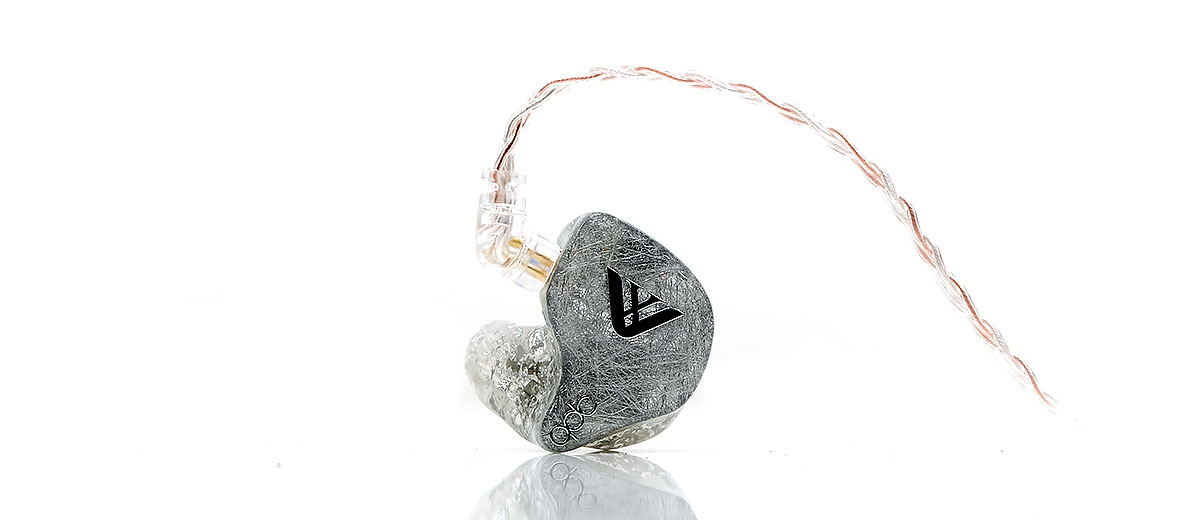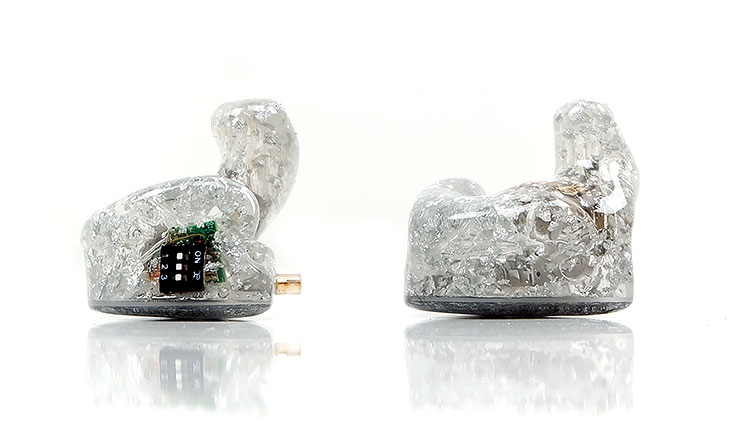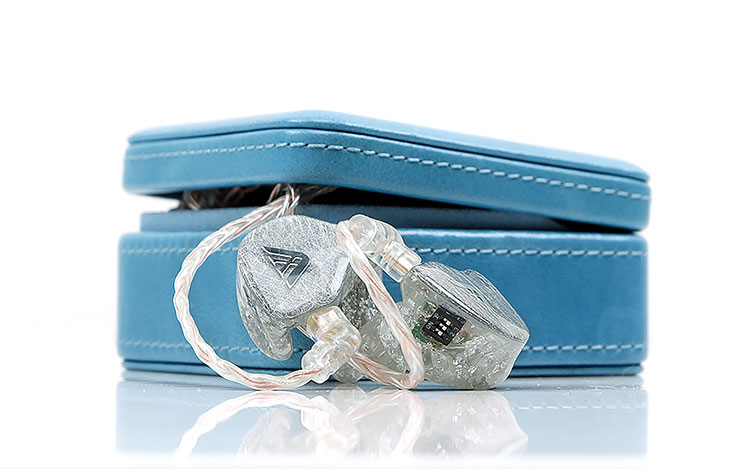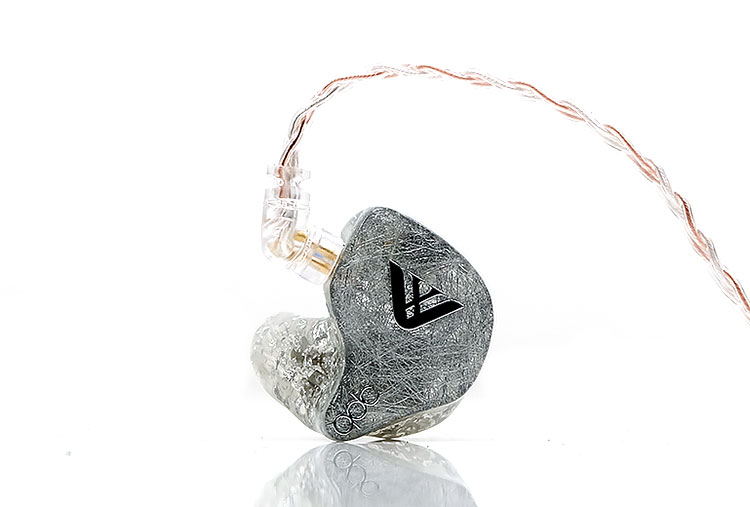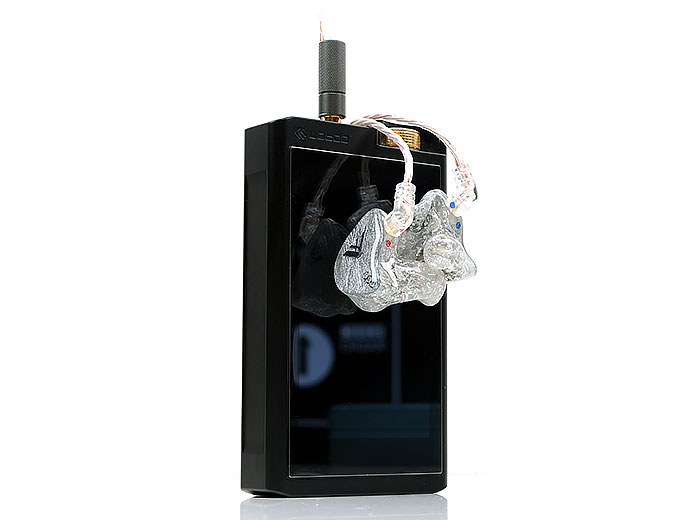Meet the Anole VX
Design
I went for the company’s core design for the VX. By that I mean the one you see in all their marketing collateral to date. This is a blend of silver and transparent tones, kind of like a frosty finish but it is quite an intricate design when viewing up close.
This seems to be a mix of silver flakes and a scratched/frost pattern faceplate inside an acrylic body with both the qdc branding and VX logo in silver right on top. The qdc logo and banner seem to be small cutouts inserted just beneath the main plate rather than imprinted directly onto them.
Honestly, it is really beautiful and unique and quite the contrast to the candy color design of the Anole V6 review unit. This is also the stock design and colors of the universal version so if you are not keen on waiting for a custom option then this is what you can expect when you buy the off-the-shelf version.
Finishing
Because the plate and body have a slightly different tone you can make out the distinct join points in the finishing unlike the ‘Magic Color’ of the Anole V6 which is more of a unibody finish. It is very subtle, however, with plenty of acrylic polish finish to minimize the transition.
The black switch box is just under the main shell on the sides with the main switch top plate accessible. The switch insertion and finishing are excellent and almost good as the smaller V6 switch design. The only real difference is the translucent shell allows you to see more of the green PC-board behind the switch.
The seal around the switch box is immaculate and the actual switches, small they might be, are very clean and easy to read. You will need a small tool to move them switches though. Even fingernails might not be enough because they are quite flush to the body.
Horn Design
The bores on the qdc Anole VX are terminated deeper into the chamber of the nozzle and not right on the tip of the nozzle, rather like the Anole V6-C. This termination point is where the “horn design” essentially starts on the VX-C.
The large open bore allows qdc to fine-tune and develop the readily mixed sound before it leaves the chamber and into the bore. In doing so, they are able to tweak the Anole V6-C’s high-frequency extension a little further than what is possible with a traditional individual tubed bore design using the same drivers.
Cables & Connectors
Ok so here is the tricky part with the qdc Anole VX-C, (and the universal) and it is the same issue if you read our V6-X review. If you are happy with the stock cable or one of the cables provided in your checkout then it will not be an issue. For those that like to swap cables and have high-performing ones then the design of the connectors (and jack) will present issues.
Protruding Sockets
The issue is two-fold. First, the connector stems on the Anole VX-C shell are protruding designs. This is a design I have seen before with Unique Melody customs and in all honesty, I do find them stronger and more comfortable with the cable connectors angled to gently guide the cable around the ear.
However, unless you specifically have that type of connection on your aftermarket cable the resulting connection with a regular 2-pin design loses a lot of strength and sticks out a fair bit.
Reverse Polarity
The second problem is where it gets super messy as the pins are reversed polarity as is the entire cable-to-connector design. That means any regular cables have to be connected with the pins “upside-down”. Combine that with protruding connections and it becomes a nightmare.
This is not an unworkable scenario if you are really determined or like me, you bought a small set of DIY connectors that re-orientate the polarity. I would suggest going for the connectors, (see picture below), which I managed to get locally for $50. Linsoul sells QDC to MMCX version also on Amazon also for $59.99.
Stock Cable
This is a better cable on the VX-C compared to the stock cable on the Anole V6. The cable is around 1.2m in length and a little thicker but more pliant than the V6 cable. It is also very microphonic-free. It uses a mix of 26AWG copper and silver inside an 8-core parallel wire, (4×4), geometry build. In short, it is a hybrid cable.
The stock cable is also terminated with an unbalanced 3.5mm gold-plated TRS jack with slim gun-metal colored barrels for both the jack and y-split. Strain relief is good on both sides with a pliant rubber finish on the connectors and a thick rubber tube on the jack connector. The chin cinch is a little on the cheap side being just a cut rubber tubing rather than anything sophisticated.
Comfort & Seal
The comfort levels are truly excellent. They did a great job on the V6 but the VX fitting is even better this time around. The balance between pressure, comfort, and blocking out the outside world is almost perfect. qdc has not reverted to a thick nozzle either to get that seal so good on the VX.
It does not seem to put too much pressure on my ear canal and the build is small enough that it sits nice and flush in my outer ear.
The level of isolation is outstanding also. Granted that should be the case with a BA build because it does not need venting ports as a hybrid or dynamic driver does. Even so, the low-level background noise attenuation from the likes of my air con is top-notch. I have a few custom BA-builds that do not come close to this level of isolation.
Sound Impressions
Summary
The Anole VX is like the Anole V6 on steroids. It is bigger, more powerful sounding with a better level of detail, and more extended on either end of the frequency range. Yet, it still has that smooth delivery with all the bumps in all the right places. I would even contend qdc has upped the smoothness and certainly injected a bit more richness into the VX timbre than I ever heard with the V6.
The sound is still relatively u-shaped and balanced but those “bumps in all the right places” have been tweaked a little so it is not quite the same emphasis as with the V6.
First and foremost, the low-end is powerful, much more so than the V6 with a lot more sub-bass presence, warmth, and body. Previously, I never felt the V6 as lacking in bass but compared to the VX is does sound much lighter in tone and less extended by comparison.
Mids are thicker, richer and draw much more low-end warmth allowing instruments to sound smooth and weighted in delivery. The timbre is most definitely natural to slightly euphonic in tone but also beautifully detailed with excellent texture.
Vocals are just a shade more neutral the time around in terms of positional perception. I suspect this is more to do with the enhanced low-end drawing some attention away as they still sound forward, just not as forward, (in stock form) as the V6 can be.
The one slight caveat to an otherwise stellar presentation is a slight upper mids/lower treble dip around 4-6k. It tends to just cast a slight veil on percussion timbre whereas I would prefer a little more bite. The overall tone of the treble is still relaxed but it does sound very detailed and never lacking in air.
More Flavors
Of course, switches on the VX are magical, and throwing on both treble and mids same time pushes that upper mids/lower treble presence back up in a very satisfactory manner. There is not much these switches cannot do in all honesty.
And it is these switches that make a huge difference in the VX tuning because any slight quirks in the stock presentation or something that doesn’t jive with your personal preference can be resolved with the switches. The rest? PEMQ or DSP will sort it out. The choice is power people, and the VX has no less than 8 of them this time around.
Staging
Staging on the VX is somewhat switch-sensitive. However, in its stock form, I would classify it as a natural mid-size concert hall experience so not massively grand but not intimate either. A nice live feel to the presentation with excellent depth, responsible width, and a slightly relaxed but still airy top-end.
Vocals, like the V6, are pushed further forward but this time they are countered by a more physical and forward low-end so the staging is a little more balanced and not quite as stretched as the V6 soundstage. Instruments sit a little behind vocal positions but not too far behind.
Lower-pitched drum kicks resonate strongly with excellent presence. However, higher-pitched percussion presence is dialed down a smidgen with a small lower treble dip around 4-6k. Treble is not overly emphasized so it doesn’t have a huge amount of ‘fizz’ and rarely dominates vocals.
Imaging cues are excellent though not on a 64 Audio A18 level. I don’t find myself searching for pinpoint instrument strikes on the VX as much as I do on the A18. It is not that I do not notice them but rather the VX has a tendency to make you sit back and listen rather than analyze.
Switching Influence
Each switch tips the balance in terms of stage positioning. The bass switch really ups the sub-to-midbass forwardness, depth, and body. You do get a stronger sense of power with lower-pitched instruments and a slightly closer feel to their positioning as a result.
The mids bump the 1-3k a bit more so you get a little more of a mid-centric soundstage with less power and a slightly lighter tone. Vocals are more to the fore also so the staging gets a touch more stretched from front to back as a result.
The treble switch on introduces a tasteful level of sparkle and a bit more of an ethereal quality to the absolute top-end of the VX performance. This switch for me is normally on 99% of the time when casually using the VX. It does add some perceptible higher frequency articulation and a little more odd-harmonic clarity to small imaging cues making some “hits” a little easier to pick out.
Bass Switch
I would say the bass switch adds about 5-6dB of boost to the sub-to-mid bass and eventually settles down around 300-400Hz or in the upper bass region. As a result, it is a way more aggressive low-end, sounding further forward, more physical, and with plenty of body.
The cut into the lower mids is a little deeper and it has to be to keep that transition relatively smooth since the mids and treble are not boosted like the Lime Ears Aether R and Model X curves. Whilst you also get a bit more bloom it still has a healthy level of spaciousness with a resolving neutral DAP such as the Lotoo PAW Gold Touch.
I tend to prefer this setting with non-vocal tracks where I want a bit of power and menace in my lowest pitching synth or drum kicks. You do lose a little mids clarity and treble presence though they do not so much diminish but rather resonate a less in your listening as the balance takes on more of a bass bias.
Mids Switch
This is a switch I tend to leave on quite a lot, (along with the treble switch). From what I hearing the lower-mids seem to rise a lot faster than on stock mode and from about 1-4k you get about a 1-2dB enhancement overall. I don’t get a feeling it dramatically reduces that softness in the upper mids lower treble and it might just be out of range for this setting to have any effect.
This is my vocal enhancer and I just love it. It won’t offer quite the extreme push as the V6 setting given vocals on the VX are a touch more neutral in their positioning. They do, however, deliver a bit more presence and “pop” which I especially appreciate with male rock vocals when I need them to climb above the cacophony of guitar and drum often bubbling with intensity underneath.
Treble Switch
However, the VX really excels when the treble switch is turned on, and in particular when you turn it on with the mids switch. On its own, the treble switch adds a bit of sparkle and some welcome enhanced contrast to the smoother warmth of the low-end of the VX tuning.
It is probably the most nuanced of settings on the VX because it doesn’t really extend lower than 6-7k and instead targets that 7-10k range with about a 1-2dB increase. It is just enough to bring some odd-harmonic balance without any brittle or harsh imbalance to the stock tuning of the VX.
Other combinations
Mids/Treble
However, the treble switch is really one-half of the main act for me. You need to turn on both mids and treble switches to clean up the upper mids and get a smooth energetic transition into the treble in general. It does not upset the overall sweet-sounding percussion timbre nor will it ever sound harsh or sibilant. Rather, it just sounds more extended, more alive, and more engaging.
This is by far my favorite setting and pushes the VX way up there in terms of clarity, sparkle, and coherency. That necessary level of contrast in the VX’s percussion timbre is where the engagement and excitement kick in.
It also stretches the staging a little bit more to my liking and leaves a bit more room for vocals which are already enhanced from the mids switch. Is it shouty? I don’t think so, not at all. Less of a veil is more of my thinking here.
All Switches On
You can, of course, elect to switch on all three switches for the full all-out tweak experience. However, I am not a huge fan of all three being turned on.
The bass is probably where the most additional dB is added when you start messing around with switch boosting. I think it tends to overpower the mids a little and you start veering more to a v-Shaped signature and you loos a bit of mids prominence and vocal clarity as a result.
Click on Page 3 below for Pairings & Comparisons

